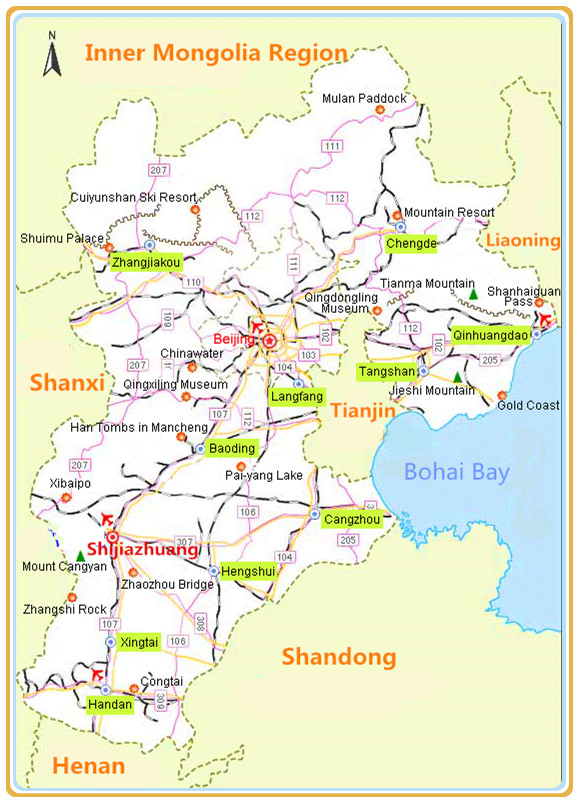The topography of Hebei slopes from the northwest to the southeast with complicated and varied landforms. Hebei is the sole province with seashore, plains, lakes, hills and plateaus and has a large quantity and variety of natural resources.
The province adjoins Tianjian and the Bohai Sea in the east and the provinces of Shangdong and Henan in south. It lies along the Taihang Mountains and neighbors Shanxi province in the west, has a common boundary with the Inner
Mongolia autonomous region in the north and borders on Liaoning province in the northeast.
Hebei boasts rich tourism resources including two of the Top Ten national Tourist Attractions in China, two of the World Geoparks and 60 National Forest Parks and Natural Reserves. It is the only province that owns coasts, plains, lakes, hills, mountains and plateaus and it can be called the miniature of China’s landform.
Hebei boasts profound history, with 6 World Cultural Heritages, 6 National Famous Historical and Cultural Cities, 278 National Cultural Heritage sites. Two million years ago, there was already the trace of human activities in Nihewan Basin in Yangyuan County. According to the Records of the Grand Historian,5000 years ago,the ancestor to all Chinese-the Yellow Emperor had a fight with Yan Emperor and Chiyou in the current Zhuolu County and merged into a new tribe. 2000 years ago, the state of Yan and state of Zhao had existed here, that’s why it’s also called Yanzhao Land. Yuan, Ming and Qing Dynasties had chosen Beijing as their capital, so Hebei became an important environs that protects Beijing. Hebei Museum showcases nearly 240,000 cultural relics among which there are 340 first-class relics. The exquisite and impressive crafts are the essence of the profound history and culture of Yanzhao Land.
The splendid history, culture and natural scenes enhance each other’s beauty and make Hebei a colorful and pleasant tourist attraction.
Hebei has the well-developed transportation. The mountains and rivers in Hebei are closely connected to those in Beijing and
Tianjin. Within the area, there are high-speed trains that expands in all directions,expressways and roads that lead to every county and village. The Jingjinji one-hour traffic circle and half-an-hour commuting circle have been built. There are six airports including Shijiangzhuang, Chengde, Zhangjiakou,
Qinhuangdao, Tangshan, and Handan airports and 131 international and domestic airlines in operation and the new Beijing Airport is accelerating its building. The three major ports in Northern China, Tangshan,
Qinhuangdao and Huanghua provide accesses to more than 400 ports in the world.
Now Hebei is standing on a new point and faced with important strategic opportunities like the integrated development of
Jingjinji Area, establishing the Xiong’an New Area, and Zhangjiakou co-hosting the 2022 Winter Olympics with Beijing. Hebei is taking the opportunities to involve beauty in every aspect of our nature and human activities, in every corner of our rural and urban areas, in every inch of our land and endeavor to build a more beautiful, splendid, open, inclusive and pleasant Hebei.
 Hebei province, which surrounds the capital Beijing, covers a total area of 188,800 sq km with a total population of 75 million.. The provincial capital Shijiazhuang is 283 km from Beijing in the north.The name Hebei literally means "north of the river", referring to its location entirely to the north of the Yellow River.
Hebei province, which surrounds the capital Beijing, covers a total area of 188,800 sq km with a total population of 75 million.. The provincial capital Shijiazhuang is 283 km from Beijing in the north.The name Hebei literally means "north of the river", referring to its location entirely to the north of the Yellow River. Ask Questions ?
Ask Questions ?